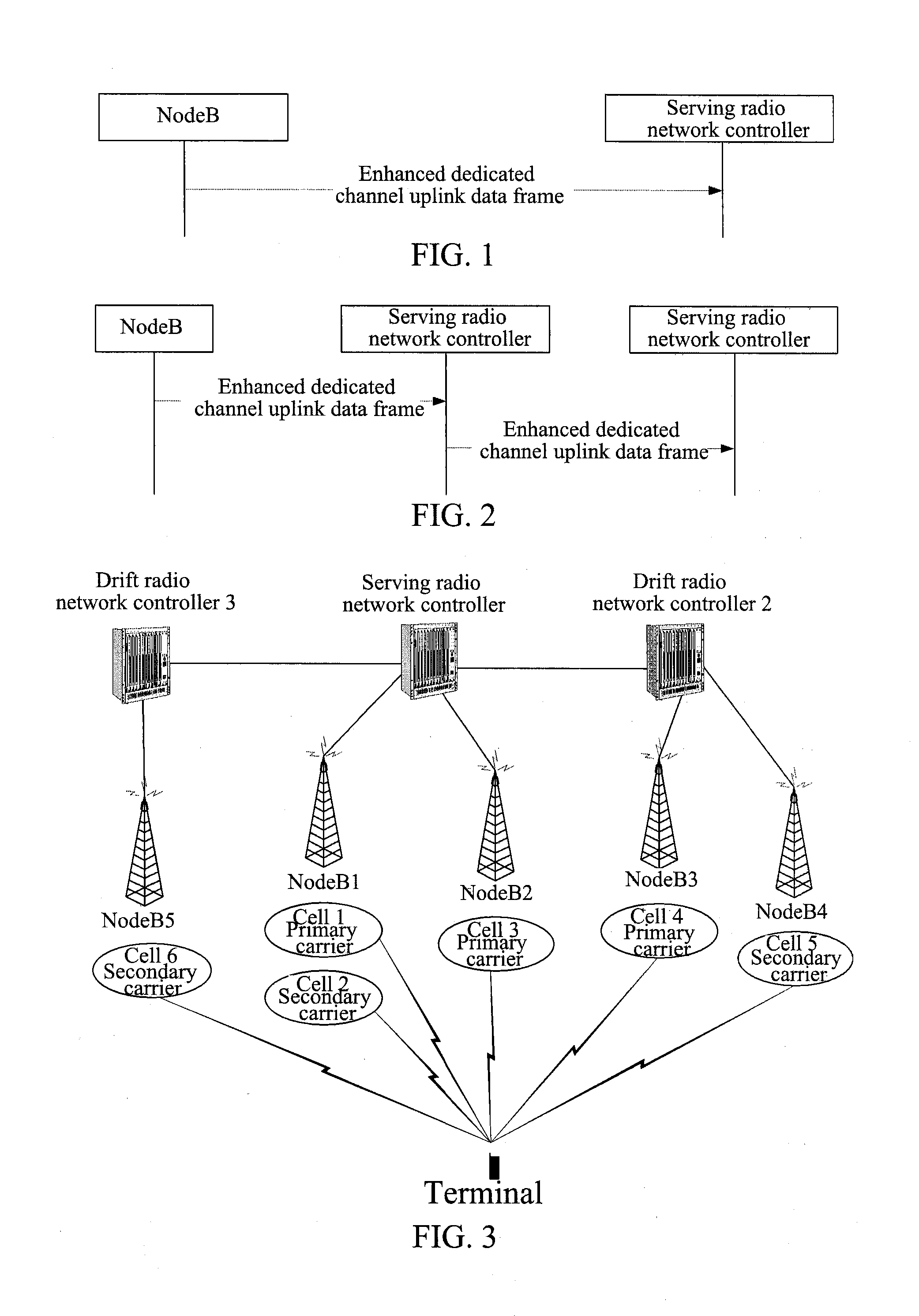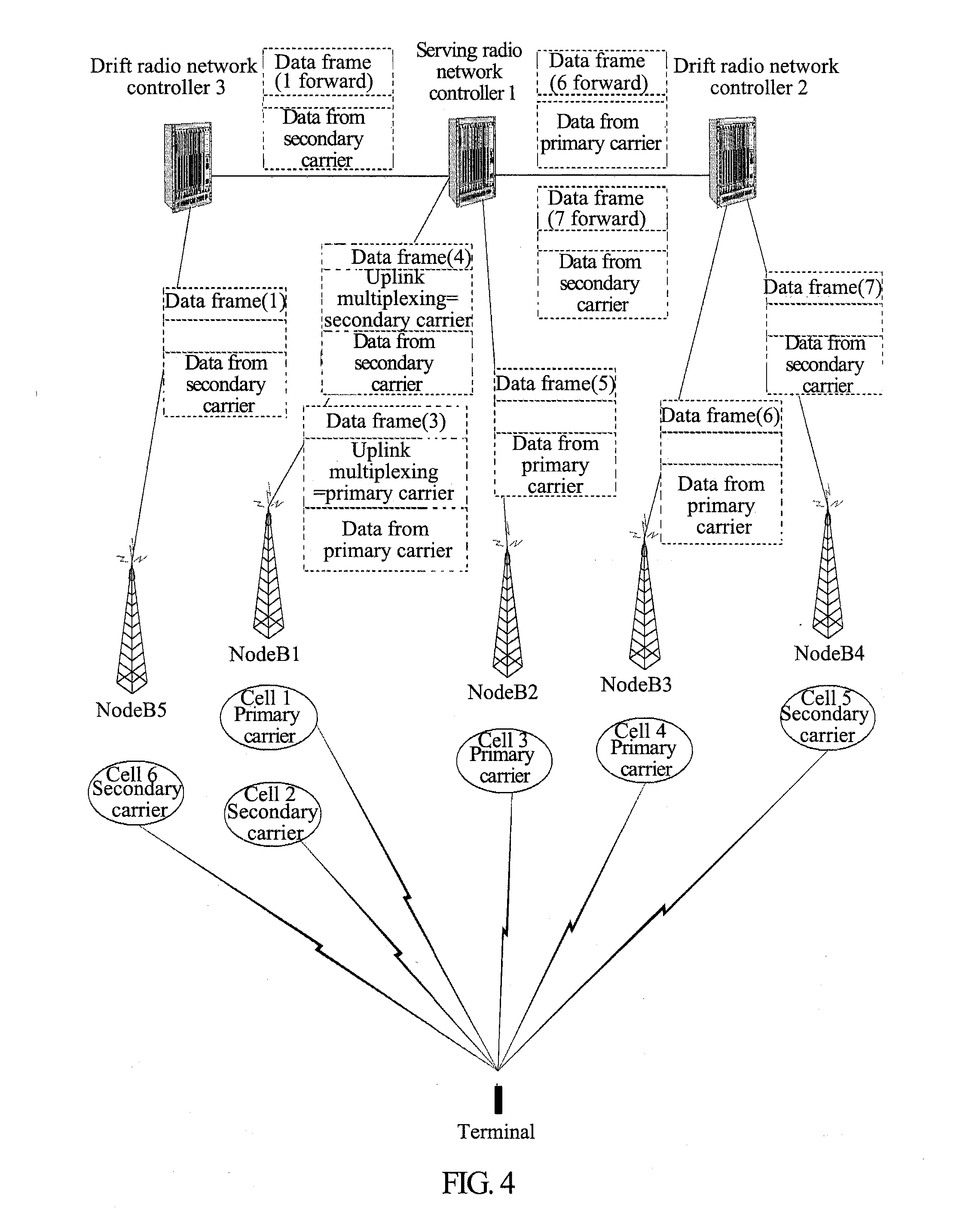Method and system for transmitting muti-carrier uplink data at network-side
- Summary
- Abstract
- Description
- Claims
- Application Information
AI Technical Summary
Benefits of technology
Problems solved by technology
Method used
Image
Examples
first embodiment
The First Embodiment
[0079]The present embodiment describes a method for transmitting and receiving dual-carrier enhanced dedicated channel uplink data frames between NodeB 1 and radio network controller 1. NodeB 1 belongs to radio network controller 1. The processing procedure of the first embodiment is shown in FIG. 5, and each of its steps is described as follows.
[0080]In step 110, for a terminal using the dual-carrier high-speed uplink packet access technology, radio network controller 1 sets up a dual-carrier enhanced dedicated channel cell (that is, a cell using the enhanced dedicated channel in an uplink direction of one carrier in the two carriers), cell 1, through a radio link setup process in NodeB 1, and notifies NodeB 1 of a carrier identifier corresponding to the carrier of the dual-carrier enhanced dedicated channel cell in the multiple carriers. The carrier identifier corresponding to the carrier of cell 1 in the two carriers is the primary carrier.
[0081]In step 120, f...
second embodiment
The Second Embodiment
[0088]The present embodiment describes a method for transmitting and receiving dual-carrier enhanced dedicated channel uplink data frames between NodeB 5 and radio network controller 1 (serving radio network controller) via radio network controller 3 (drift radio network controller). NodeB 5 belongs to radio network controller 3 (drift radio network controller). The processing procedure of the second embodiment is shown in FIG. 6, and each of its steps is described as follows.
[0089]In step 210, for a terminal using the dual-carrier high-speed uplink packet access technology, radio network controller 1 sets up a dual-carrier enhanced dedicated channel cell (that is, a cell using the enhanced dedicated channel in an uplink direction of one carrier in the two carriers), cell 6, through a radio link setup process in radio network controller 3, and notifies radio network controller 3 of a carrier identifier corresponding to the carrier of the dual-carrier enhanced de...
third embodiment
The Third Embodiment
[0095]The present embodiment describes a method for transmitting and receiving a dual-carrier enhanced dedicated channel uplink data frame between NodeB 3 and NodeB 4 and radio network controller 1 (serving radio network controller) via radio network controller 2 (drift radio network controller). NodeB 3 and NodeB 4 belong to radio network controller 2 (drift radio network controller). The processing procedure of the third embodiment is shown in FIG. 7, and each of its steps is described as follows.
[0096]In step 310, for a terminal using the dual-carrier high-speed uplink packet access technology, radio network controller 1 sets up a dual-carrier enhanced dedicated channel cell (that is, a cell using the enhanced dedicated channel in an uplink direction of one carrier in the two carriers), cell 5, through a radio link setup process in radio network controller 2, and notifies radio network controller 2 of a carrier identifier corresponding to the carrier of the du...
PUM
 Login to View More
Login to View More Abstract
Description
Claims
Application Information
 Login to View More
Login to View More - R&D
- Intellectual Property
- Life Sciences
- Materials
- Tech Scout
- Unparalleled Data Quality
- Higher Quality Content
- 60% Fewer Hallucinations
Browse by: Latest US Patents, China's latest patents, Technical Efficacy Thesaurus, Application Domain, Technology Topic, Popular Technical Reports.
© 2025 PatSnap. All rights reserved.Legal|Privacy policy|Modern Slavery Act Transparency Statement|Sitemap|About US| Contact US: help@patsnap.com



